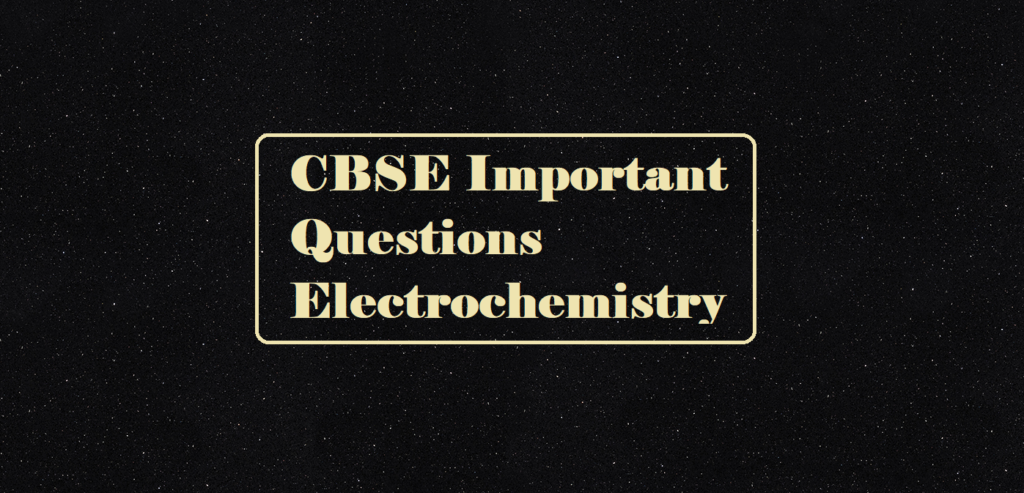Chemistry Class 12 Syllabus (Term – 2)
Chemistry Class 12 Syllabus
Class 12 Chemistry Syllabus (Term – 2) for session 2021-22 is given below for the students along with the number of marks for each branch of chemistry. Class 12 Chemistry Syllabus is very important for the upcoming examinations. It is important for the students to go through the Class 12 Chemistry Syllabus (Term – 2).
| Unit No. | Unit Name | Periods | Branch | Marks |
| 3 | Electrochemistry | 7 | Physical Chemistry | 13 |
| 4 | Chemical Kinetics | 5 | ||
| 5 | Surface Chemistry | 5 | ||
| 8 | d & f – Block Elements | 7 | Inorganic
Chemistry |
9 |
| 9 | Coordination Compounds | 8 | ||
| 12 | Aldehydes, Ketones and Carboxylic Acids | 10 | Organic Chemistry | 13 |
| 13 | Amines | 7 | ||
| Total | 49 | 35 |
Unit 3: Electrochemistry
- Redox reactions
- EMF of a cell,
- Standard electrode potential
- Nernst equation and its application to chemical cells
- Relation between Gibbs energy change and EMF of a cell
- Conductance in electrolytic solutions
- Specific and molar conductivity
- Variations of conductivity with concentration
- Kohlrausch’s Law of electrolysis.
Deleted Portion:
- Law of electrolysis (elementary idea)
- Lead accumulator
- Fuel cells
- Corrosion
- Law of electrolysis
- Dry cell – electrolytic cells
- Galvanic Cells
Unit 4: Chemical Kinetics
- Rate of a reaction (Average and instantaneous)
- Factors affecting rate of reaction: Concentration, Temperature, Catalyst
- Order and molecularity of a reaction
- Rate law and specific rate constant
- Integrated rate equations
- Half-life (only for zero and first-order reactions).
Deleted portion:
- Concept of collision theory (elementary idea, no mathematical treatment)
- Activation energy
- Arrhenius equation
Unit 5: Surface Chemistry
- Adsorption, physisorption, and chemisorption
- Factors affecting adsorption of gases on solids
- Colloidal state: the distinction between true solutions, colloids, and suspension
- Lyophilic, lyophobic, multi-molecular, and macromolecular colloids
- Properties of colloids; Tyndall effect, Brownian movement, electrophoresis, coagulation.
Deleted Portion:
- Emulsion – types of emulsions
- Catalysis: Homogeneous and heterogeneous
- Activity and selectivity of solid catalysts
- Enzyme catalysis
Unit 8: d-and f-Block Elements
- General introduction
- Electronic configuration
- Occurrence and characteristics of transition metals
- General trends in properties of the first-row transition metals – Metallic character, Ionization enthalpy, Oxidation states, Ionic radii, Colour, Catalytic property, Magnetic properties, Interstitial Compounds, Alloy formation.
- Lanthanoids – Electronic configuration, Oxidation states, Lanthanoid contraction, and its consequences.
Deleted Portion:
- Preparation and properties of K2Cr2O7 and KMnO4
- The chemical reactivity of lanthanides
- Actinides-Electronic configuration
- Oxidation states and comparison with lanthanide
Unit 9: Coordination Compounds
- Coordination compounds
- Introduction to: Ligands, Coordination number, Colour, Magnetic properties and shapes
- IUPAC nomenclature of mononuclear coordination compounds
- Bonding, Werner’s theory
- VBT, and CFT.
Deleted Portion:
- Structure and stereoisomerism
- Importance of coordination compounds
- Actinoids: Electronic configuration, Oxidation states, and comparison with lanthanoids.
Unit 12: Aldehydes, Ketones, and Carboxylic Acids
- Aldehydes and Ketones
- Nomenclature,
- Nature of carbonyl group,
- Methods of preparation,
- Physical and chemical properties
- Mechanism of nucleophilic addition reaction
- Reactivity of alpha hydrogen in aldehydes
- Carboxylic Acids
- Nomenclature
- Acidic nature
- Methods of preparation
- Physical and chemical properties
- Uses
Deleted Portion: No Change
Unit 13:
- Amines
- Nomenclature
- Classification, structure
- Methods of preparation
- Physical and chemical properties
- Uses
- Identification of primary, secondary, and tertiary amines.
Deleted Portion:
- Diazonium salts
- Preparation
- Chemical reactions and importance in synthetic organic chemistry.
Chemistry Class 12 Syllabus
Advertisement



